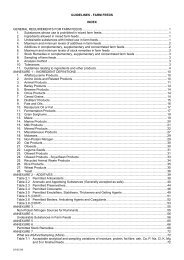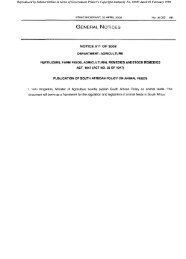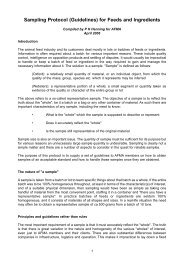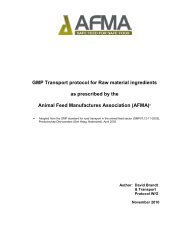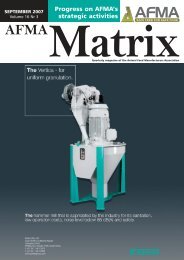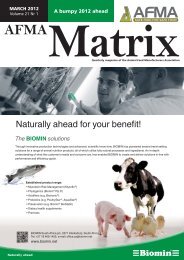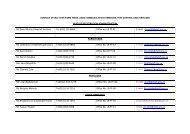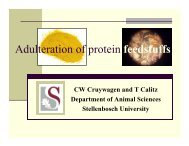Create successful ePaper yourself
Turn your PDF publications into a flip-book with our unique Google optimized e-Paper software.
Biofuel co-products as livestock feed<br />
– opportunities and challenges<br />
by Harinder PS Makkar, Livestock Production Systems Branch,<br />
Animal Production and Health Division, FAO, Rome, Italy<br />
Distillers grains (DG), a by-product of the alcoholic<br />
drink and beverages production, have been fed to<br />
livestock for several years, initially to pigs and dairy<br />
cows. The upsurge in the use of DG was spearheaded<br />
by the search for transport fuel other than that from<br />
fossil fuels, which in recent years has been supported by a large increase<br />
in research funding into the use of co-products.<br />
The co-products are the residues after extraction of the biofuel –<br />
ethanol or biodiesel. Currently, these co-products are an important feed<br />
resource in over 50 countries, for ruminants, non-ruminants and fish.<br />
Biofuels contribute to the twin objectives of increasing fuel security<br />
and as a tool in the reduction of greenhouse gas (GHG) emissions. As<br />
the majority of currently used feedstocks to produce biofuels are crops<br />
grown on agricultural land, the requirements for food, feed and fuel<br />
must be balanced so that the quest for biofuels does not result in an<br />
inflationary rise in the cost, or shortage, of food or feed.<br />
This raises the question of second-generation feedstocks from<br />
cellulosic sources, the use of crop residues and stubbles and woody<br />
material grown on marginal land with a minimum of resources, including<br />
irrigation. It also raises the potential for promoting littleused<br />
feeds from non-conventional feedstocks, of which some may<br />
require detoxifying to produce safe livestock feed.<br />
Processing<br />
Feedstocks for ethanol production<br />
Cereal feedstocks: In the USA corn or maize is the dominant source.<br />
The USA has also built an export trade in dried distillers grains with<br />
added solubles (DDGS), initially to Canada for beef production, but<br />
now expanded to a wider market with an emphasis on pig and poultry<br />
production. In the Southern Great Plains of the USA sorghum is<br />
an important feedstock, thus giving rise to considerable quantities of<br />
co-products based on this cereal.<br />
In Canada the major cereal contributing to the industry is wheat.<br />
In Europe the dominant feedstock for ethanol production is also<br />
wheat, although some other cereals, especially barley, may be added<br />
to the mix. Rye is also used as a feedstock, but it is restricted to colder<br />
areas.<br />
Sugar cane and other non-cereal feedstocks: Sugar cane is also<br />
a major feedstock for ethanol production. On a global scale 90% of<br />
ethanol output is accounted for by corn and sugar cane. Other feedstocks<br />
include tropical sugar beet, sweet potato, cassava and sweet<br />
sorghum.<br />
Ethanol co-products<br />
In the USA there are now 200 plants producing 35 million tons of<br />
co-products annually, an increase of more than 13-fold compared<br />
with 2000. Ethanol production was estimated at 51 billion litres in<br />
2010, over three times as much as in 2005.<br />
Currently, in the USA, the beef industry uses 66% of the<br />
available distillers grains, the dairy industry 14%, pigs 12%<br />
and poultry 8%; at the present time there is little evidence of<br />
meaningful amounts is used in aquaculture. However, due to<br />
the high price of the traditional protein sources, fishmeal and<br />
soya bean meal, and the comparatively low price of DDGS, its<br />
use is expected to increase.<br />
<strong>AFMA</strong> MATRIX ● APRIL <strong>2013</strong> 23



